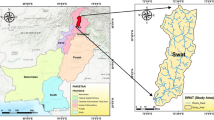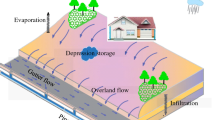Abstract
In recent years, flash flood disasters have occurred frequently in southwest China due to the increased frequency of extreme climate events. To solve this problem, great efforts have been made in studying the process of flash flood. However, little attention was paid on bearing body of hazard, the clusters of buildings. Thus the real disaster mechanism of flash flood remains unclear. Accordingly, based on the experiments of artificial flash floods in a conceptual solid model, this paper focuses on the flood-impacted inundation characteristics of the building clusters at different locations of the gully model, in order to obtain a better understanding of the disaster process and the interaction between the flash floods and building clusters. The results showed that, in a typical smallscale flash flood gully with hot and dry climate, 1) clusters of buildings on an alluvial fan could reduce about 35% of the flooding area by blocking the diffusion of the flood to the depression areas, and could also promote the deposition in lower reaches of the river channel by blocking the overbank flow from going back into the channel, making the width-depth ratio of the channel larger. 2) The flash flood rates of disaster and hazard on the alluvial fan are generally higher than that of the inner gully. For the inner gully, buildings located on the beaches along the lower river and the transitional areas of the straight channel and channel bends can easily be affected because of their lower elevations. For the alluvial fan, buildings nearby the meanders suffer the greatest impacts because of bank collapsing and flooding. 3) The safe vertical distance from a building to the river channel is 13 m for the buildings in the inner gully under extreme floods. Below this threshold, the smaller the vertical distance is, the greater the risk exposure is. For the buildings on the alluvial fan, especially for the buildings near the concave bank of the top rush point, the horizontal distance is more important, and the safe value is 80 m under extreme floods.
Similar content being viewed by others
References
Changnon S, Kundel K (1999) Record flood-producing rainstorms of 17-18 July 1996 in the Chicago Metropolitan area. part I: Synoptic and Mesoscale features. Journal of Applied Meteorol 38: 257–265. DOI: 10.1175/1520-0450 (1999)038<0257:RFPROJ>2.0.CO;2
Chen NS, Yang CL, Zhou W, et al. (2009) The critical rainfall characteristics for torrents and debris flows in the Wenchuan earthquake stricken area. Journal of Mountain Science 6 (4): 362–372. DOI: 10.1007/s11629-009-1064-9
Chen XQ, Xie H (1999) Study on regionalization of debris flow danger degree under GIS support. Journal of Soil Erosion and Soil and Water Conservation 5 (6): 46–50. (In Chinese)
Cui P, Liu SJ, Tan WP (2000) Progress of debris flow forecast in China. Journal of Natural Disasters 9 (2): 10–15. (In Chinese)
Delrieu G, Ducrocq V, Gaume E, et al. (2005) The Catastrophic Flash-Flood Event of 8–9 September 2002 in the Gard Region, France: A First Case Study for the Cévennes–Vivarais Mediterranean Hydrometeorological Observatory. Journal of Hydrometeor 6: 34–52. DOI: 10.1175/JHM-400.1
Fuchs S, Heiss K, Hübl J (2007) Towards an empirical vulnerability function for use in debris flow risk assessment. Natural Hazards and Earth System Sciences 7: 495–506.
Gan JJ, Sun HY, Huang RQ, et at. (2012) Study on mechanism of formation and river blocking of Hongchuangou giant debris flow at Yingxiu of Wenchuan County. Journal of Catastrophology 27 (1): 5–16. (In Chinese)
Gao YZ, Xing JJ, Wang CL, et al. (2006) Cause and forecast of mountain flood from rainstorm. Journal of Natural Disasters 15 (4): 65–70. (in Chinese)
Gaume E, Livet M, Desbordes M, et al. (2004) Hydrological analysis of the river Aude, France, flash flood on 12 and 13 November 1999. Journal of Hydrology 30: 135–154. DOI: 10.1016/j.jhydrol.2003.09.015
He BS, Huang XL, Guo L (2012) The prevention route and its core constructive content of flash flood disasters in China. China Flood & Drought Management (5): 19–33. (In Chinese)
Hollingsworth R, Kovacs GS (1981) Soil slumps and debris flows: prediction and protection. Bulletin of the Association of Engineering Geologists 38 (1): 17–28. DOI: 10.1016/j.jhydrol.2003.09.015
Hsu SC (2003) A QoS-Enabled Multicast Routing Algorithm for Supporting Streaming Service. phD Dissertation, National Cheng Kung University, Chinese Taipei.
Li Y (1999) Judgement on hazard degree of debris flow based on energy analysis. Journal of Natural Disasters 8 (2): 168–171. (In Chinese)
Liu CZ, Miao TB, Chen HQ, et al. (2011) Basic feature and origin of the “8.8” mountain torrent-debris flow disaster happened in Zhouqu County, Gansu, China. Geological Bulletin of China 30 (1): 141–150. (In Chinese)
Liu GX, Wu WX, Zhang XJ (2008) Assessment of debris flow risk in Dongchuan District, Kunming City. The Chinese Journal of Geological Hazard and Control 19 (3): 13–16. (In Chinese)
Liu XL, Mo DW (2001) The basic topics of prediction and forecast for geomorphic hazards — taking debris flow as an example. Journal of Mountain Research 19 (2): 150–156. (In Chinese)
Liu XL (1988) Study of hazard judgment on debris flow. Journal of Catastrophology 3 (3): 10–15. (In Chinese)
Mao YW, Zhou YH, Cheng ZH, et al. (2005) Analysis of influence of rainfall factors on mountain floods and geological disasters in Hubei Province. Rock and Soil Mechanics 26 (10): 1657–1662. (In Chinese)
Meir IA, Avni Y, Peeters A, et al. (2013) A disaster waiting to happen—on the dynamic relations between geological processes and development in a desert environment. Landscape and Urban Planning 113: 19–29. DOI: 10.1016/j.landurbplan.2013.01.012 Mukhopadhyay B, C
ornelius J, Zehner W (2003) Application of kinematic wave theory for predicting flash flood hazards on coupled alluvial fan–piedmont plain landforms. Hydrological Processes 17: 839–868. DOI: 10.1002/hyp.1241
Pereiraab P, Olivacd M, Baltrenaite E (2010) Modelling extreme precipitation in hazardous mountainous areas. Contribution to landscape planning and environmental management. Journal of Environmental Engineering and Landscape Management 18 (4): 329–342. DOI: 10.3846/jeelm.2010.38
Schmittner K, Giresse P (1996) Modelling and application of the geomorphic and environmental controls on flash flood flow. Geomorphology 16: 337–347. DOI: 10.1016/0169-555X(96)00002-5
Su PC, Wei FQ, Xie T (2012) Causal analysis of debris flow on august 18, 2010 in Gongshan, Yunnan Province and its harm to the development and utilization of mineral resources. Resources Science 34 (7): 1248–1256. (In Chinese)
Tang C, Tie YB (2009) Reconnaissance and analysis on the rainstorm induced debris flow in Weijiagou Valley of Beichuan City after the Wenchuan Earthquake. Journal of Mountain Science 27 (5): 625–630. (In Chinese)
Tang C, Zhu J (2005) A GIS Based Regional Torrent Risk Zonation. Acta Geographica Sinica 60 (1): 87–94. (In Chinese)
Tang XC, Tang BX (1994) Several problems on study on calamity landforms and its control in China. Journal of Natural Disasters 3 (1): 70–74. (In Chinese)
Totschnig R, Sedlacek W, Fuchs S (2011) A quantitative vulnerability function for fluvial sediment transport. Natural Hazards 58, 681–703. DOI: 10.1007/s11069-010-9623-5
Tsai CW, Yen B (2001) Linear analysis of shallow water wave propagation in open channels. Journal of Engineering Mechanics 127 (5): 459–472. DOI: 10.1061/(ASCE)0733-9399(2001)127:5 (459)
Tsai CW (2005) Flood routing in mild-sloped rivers-wave characteristics and downstream backwater effect. Journal of Hydrology 308 (1/4): 151–167. DOI: 10.1016/j.jhydrol.2004.10.027
Xu RY, Zhong DY, Wu BS (2012) Additional assistance of buildings in numerical simulation of mountain torrents. Journal of Hydraulic Engineering 43Supp: 74–78. (In Chinese)
Zhou CH, Wan Q, Huang S, et al. (2000) A GIS-based approach to flood risk zonation. Acta Geographica Sinica 55 (1): 15–24. (In Chinese)
Zhu J (1995) Judgement of debris flow ravines and evaluation of risk degree of debris flows. Arid Land Geography 18 (3): 63–71. (In Chinese)
Zhu J (2010) Urban flash-flood risk assessment: A case study in Wenshan City, Yunnan. Geographical Research 29 (4): 655–664. (In Chinese)
Xiao SY, Yang LJ, Yue B, et al. (2010) Experimental Study on the impact of flood on rural building model with the liquid in a cylindrical container under pitching excitation. Journal of Disaster Prevention and Mitigation Engineering 30 (3): 235–240. (In Chinese)
Yu W, Ge XL, Zhu LX, et al. (2010) Simulated experimental study on model of buildings in mountain area under flow action. Journal of Beijing Jaotong University 35 (1): 24–27. (In Chinese)
Zhu SC, Lv JY (2011) Countermeasures to prevention and management of flood and mud-rock flow disasters in villages and towns. Cities and Disaster Reduction (4): 14–17. (In Chinese)
Author information
Authors and Affiliations
Corresponding author
Additional information
http://orcid.org/0000-0003-4932-3276
http://orcid.org/0000-0002-8032-216X
http://orcid.org/0000-0001-9825-7119
http://orcid.org/0000-0001-8918-1503
http://orcid.org/0000-0002-7813-0716
Rights and permissions
About this article
Cite this article
Du, J., He, Xy., Wang, Zy. et al. Experimental study of the interaction between building clusters and flash floods. J. Mt. Sci. 12, 1334–1344 (2015). https://doi.org/10.1007/s11629-014-3170-6
Received:
Accepted:
Published:
Issue Date:
DOI: https://doi.org/10.1007/s11629-014-3170-6




